Pruning roses in summer after flowering
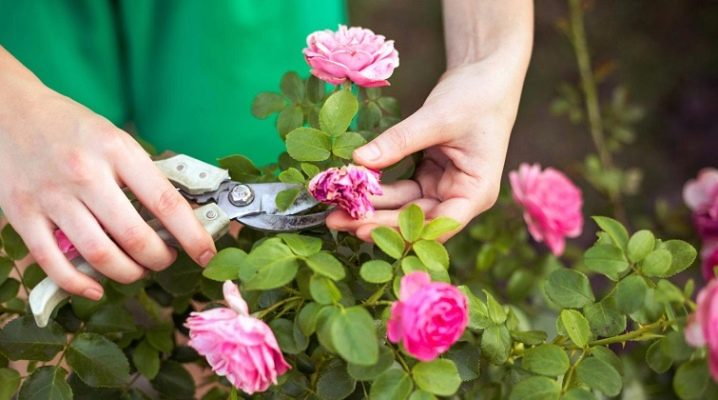
Growing a rose is not only watering, timely weeding and feeding. This is also a regular pruning, the specifics of which are worth looking at in more detail. Why you need to prune roses in the summer after flowering - a detailed answer in the article.
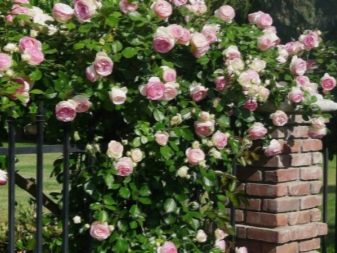
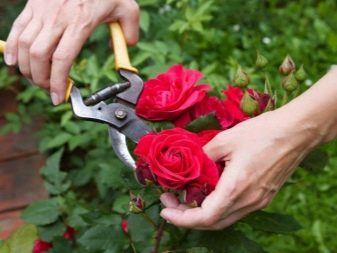
The need for a procedure
Pruning is a mandatory procedure that is carried out for both rose bushes and other plants. Gardeners strongly recommend removing wilted shrub flowers after the first wave in order to prevent the plant from forming bolls with rosehip seeds, as well as to strengthen the flower's immunity. Correct pruning acts as a stimulant for young rose shoots, which immediately start growing and begin to form new buds. This procedure allows you to get the maximum number of attractive and lush flowers with a rich and pleasant aroma over the summer.
That is why caring for a rose includes not only timely watering or feeding, but also pruning the plant in accordance with simple recommendations. But it should be noted that regardless of the amount of pruning, there are varieties that will still bloom only once per season, and pruning them will not lead to stimulation of the bush's re-flowering. Thus, cropping will help:
- accelerate the growth of new shoots;
- improve the work of the root system;
- restore nutrition to the bush;
- prevent the spread of fungi and other diseases.
Cut cuttings do not need to be thrown away. They are suitable for the breeding procedure if there is a desire to get a new bush.
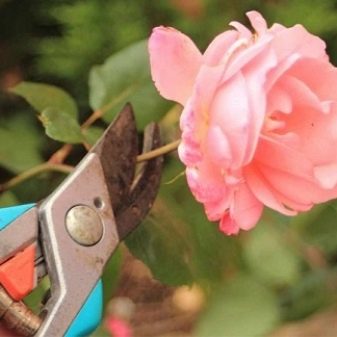
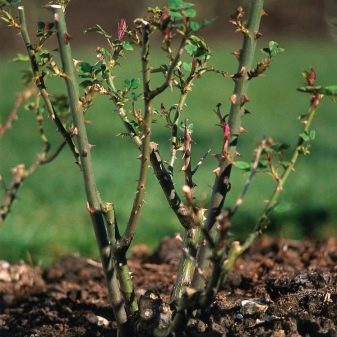
Timing
Summer pruning takes place mainly in June or July. The exact timing is determined by the climate in which the bush grows, as well as the peculiarities of the cultivation of the crop by the gardener and his personal preferences. If you approach the procedure correctly and provide for the observance of the necessary conditions, it will be possible to get new buds instead of faded petals already 3-4 weeks after pruning.
The most important thing in pruning is not to skip the timing of when to start trimming. Gardeners are advised to rely on the condition of the buds. As soon as the petals begin to wither and fall off, you need to pick up the pruner and proceed to the task. If we consider each region of the country separately, then, for example, in Siberia or the Urals, pruning is carried out in the last days of August, therefore, beginners and experienced gardeners in these regions call the procedure autumn. The regions of the middle lane start pruning a little earlier. The south of the country can afford double pruning: in early June and early August. Thus, the roses in the south form buds three times per season.
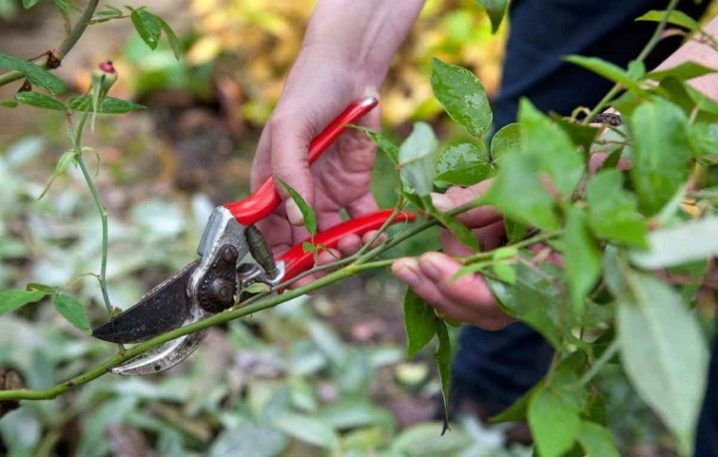
How to trim correctly?
Pruning is carried out using a special garden tool - a secateurs. Before completing the task, it is necessary to carefully process the blades of the tool with medical alcohol or vitriol solution so as not to harm the plants. Dense garden gloves provide protection from the sharp thorns of the rose.
Before pruning rose bushes, there are a few rules to take into account.
- The correct cut should be carried out exclusively over a sheet that is already fully formed. Usually this is the first five-leafed or seven-leafed bush. Some varieties allow you to cut the shoot at the level of the fourth leaf.It is also important to pay attention to the fact that the formed bud looks outward, looking out of the shoot axle. In this case, the direction of the buds must also be taken into account, but only so that the shoots do not then begin to grow inward, where they will also release buds.
- The cut should be carried out in the direction of growth of the shoot or bud at a slight angle. Then it will be possible to achieve rapid removal of liquid at the cut site and accelerate the regeneration of the plant wound. If you cut the shoot perpendicularly, the likelihood of developing serious diseases in the whole bush increases.
- After cutting the shoot, it is important to treat the damaged area with a garden varnish or other special compounds. This will help maintain the culture's immunity and speed up its recovery.
- It is important that the cut point is higher than the living shoot bud. The average distance between them should be 5 mm or more.
Cutting the shoot directly under the bud is prohibited. Otherwise, the bush will stop producing new buds.
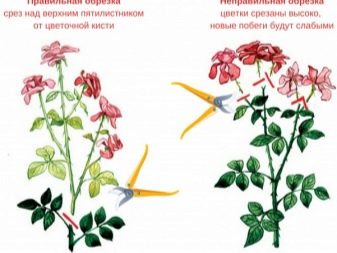
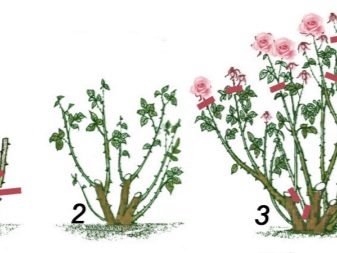
When all the necessary tools and materials are prepared, you can start the procedure. The pruning scheme is shown below.
- Inspection. First of all, the bushes are examined for the presence of wilting flowers, in which petals have begun to fall. You can also pay attention to the fully blossoming buds.
- Pruning. In addition, with the buds, gardeners remove stems that are deformed or growing in the wrong direction. Pruning is carried out by cutting off a part of the stem with a flower, which includes the bud itself and up to 5 small leaves. It is important to remove the buds and branches taking into account the growing point.
- Cleaning. After the main pruning, the gardener once again examines the bushes to identify damaged shoots and buds. Such elements must also be removed in order to prevent the spread of the disease to the entire bush or other plants.
Sometimes gardeners have to prune an entire plantation of shrubs. In this case, you should forget about scrupulousness. It is allowed to cut off shoots at a distance of up to 8 cm above the selected leaf. Also, often healthy shoots do not form buds. In such situations, it is necessary to understand that the shoot does not have a growing point, and it can be easily removed by cutting just below one or two leaves. The last step in each pruning is to feed the plant that has experienced stress. It is recommended to use herbaceous infusions, organic mixtures in the form of chicken or cow dung, and horse manure as fertilizers. The latter components should be dissolved in water in a ratio of 1: 10, respectively. You can also feed the plant with special formulations that are sold in gardening stores. However, before that, you should carefully study the instructions.
Timely pruning will not only promote the formation of new buds and eliminate the risk of seed formation. Using the procedure, you can prevent the development of fungal diseases that occur during rain, as well as reduce the risk of insect attacks on weak shoots.
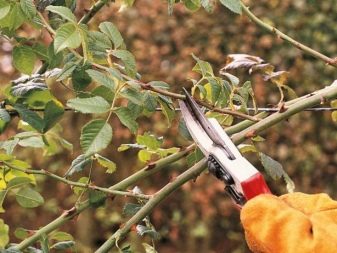
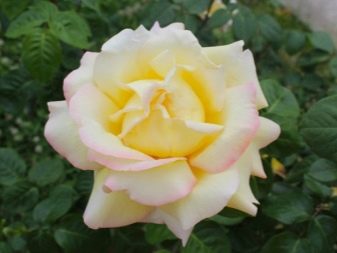
Features of cropping of different types
Shrub roses are attractive plants with lush buds that attract attention with their vibrant colors and rich aroma. Pruning will help your rose bushes to bloom regularly, prevent the development of various diseases and reduce the risk of pest attacks.
The standard pruning scheme for most varieties is the same, but there are a number of nuances that need to be considered when cutting shoots from certain types of roses, for example, floribunda. Groundcover, English, Canadian, park and other rose bushes have their own characteristics regarding pruning. It is worth considering only the most common options.
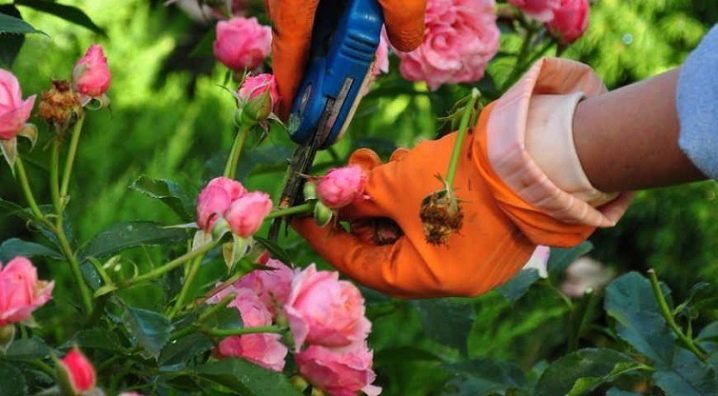
Hybrid tea
Such bushes have a ball shape characteristic only for them. The crown takes several years to form and pruning helps to achieve the desired result.It is possible to achieve the desired by removing most of the shoots, which the bush begins to actively release almost immediately after planting in the ground.
Pruning is carried out according to a certain scheme.
- With the help of a pruner, the buds are removed, leaving 2-4 specimens on the shoots, the age of which does not exceed 2 years. The maximum distance you need to retreat to trim is 15 cm from ground level.
- When pruning adult shoots, up to 6 buds are left to release new leaves and shoots. The distance from the ground surface, which must be maintained, is 20 cm.
- Mature plants need, rather, maintenance pruning, with the help of which it is possible to maintain the health of the bush.
Compliance with the scheme will allow you to get the required crown shape and make bushes of hybrid tea roses a real decoration of the garden.
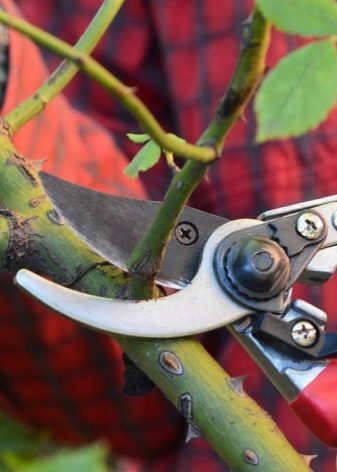

Climbing
Climbing roses are a unique type of bush flowers, the main feature of which is the intertwining shoots. The disadvantage of such a plant is that it is rather difficult to cut off old shoots due to their intertwining. Therefore, gardeners have no choice but to shorten the young shoots.
Climbing roses are pruned towards the end of August in central regions and by mid-September in more northern regions. At the same time, it is important to first inspect the plant and make sure that it has released new shoots. The maximum distance that you need to retreat from the base should be 30-40 cm.


Room
Indoor rose is an ornamental shrub that can be grown at home. It differs in small buds and compact design, in principle, therefore it is popular among owners of country houses and apartments. To prune, the gardener needs to:
- pre-inspect the plant for the presence of shoots or deformed, infected elements;
- remove young or middle-aged shoots, leaving 3 buds on each for the release of new leaves;
- wait for the bush to form updated buds and continue flowering.
It is interesting that this type of pruning is performed both in autumn and early spring.
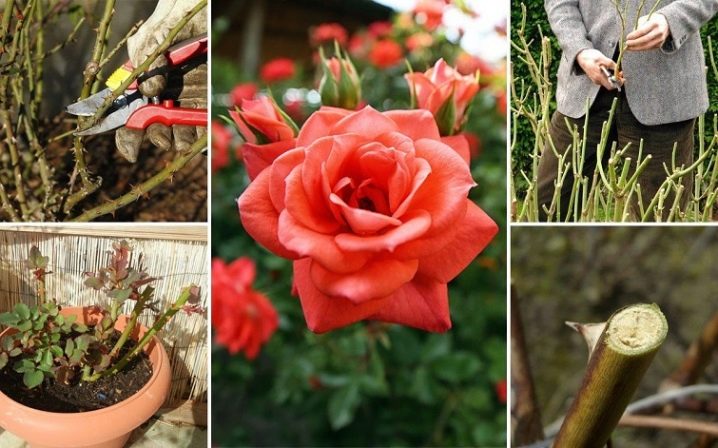

































































































The comment was sent successfully.